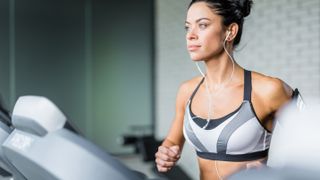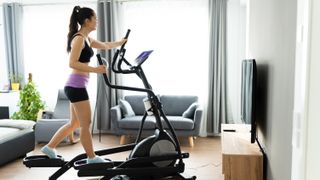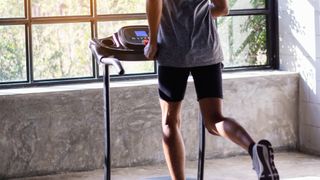Elliptical trainers vs treadmills: how to choose the right cardio machine
Everything you need to know

If your new year's resolution is to be a little healthier in 2021 – or perhaps to find new ways to stay sane in another potentially stressful year – you may be considering buying a new piece of at-home workout equipment. While just about any piece of gym equipment is available at a consumer price point, from inexpensive weight sets to high-tech (and high price) rowing machines, the most popular at-home item is the treadmill, by a large margin.
According to Mecayla Froerer, director of NordicTrack's iFit at-home personal training program, "Treadmills have been about 53 percent of total home fitness sales." Stationary bikes are second, she says, and elliptical machines come in at just eight percent of total sales. But is that because treadmills really are the best bet – or just because buyers are unfamiliar with other options?
While both treadmills and ellipticals are designed to help you sneak in a running workout at home, they're actually more distinct than most people realize. Depending on your workout goals and current health and fitness ability, one machine may end up being a much better fit for your lifestyle.
While a treadmill may very well be the right machine for you – Froerer credits her treadmill to helping her both climb Japan's Mt Fuji and run frequent marathons – some athletes may find that an elliptical is a better buy. If you're on the fence about buying a treadmill or an elliptical (also called a cross-trainer), read on to help make that decision a little easier.
Ellipticals are easier on your joints
You don't have to be an Olympic-level runner to know that it can be hard on your body; there's a multi-million dollar industry around running footwear and joint support, after all. Being on a treadmill is more like going for a run outdoors – it's the same motion, but the rotating tread keeps you in place. While some treadmill manufacturers do add a bit of cushioning, it's still a high-impact workout.
Ellipticals, however, are much lower impact. On an elliptical, you lift your heels, but your feet are always partially touching the pedals. Instead of running, the pedals (or platforms) move in a circular rotation, akin to standing on bike pedals. As you run, you'll use your arms to move the machine's arms, swinging them in tandem with the opposite leg.
Rather than running faster or increasing the incline (though those are sometimes options), users change the resistance level to create a more demanding workout. This has two advantages for your joints: you eliminate the full-body impact you experience while running, and holding the arms can relieve some weight off your legs. For anyone who has joint issues – or wants to avoid joint problems in the future – an elliptical could be a better choice.
Get the best Black Friday deals direct to your inbox, plus news, reviews, and more.
Sign up to be the first to know about unmissable Black Friday deals on top tech, plus get all your favorite TechRadar content.

Either could be better for burning calories
Which machine will burn more calories is largely dependent on you. If you're already a seasoned runner capable of running long distances or in long intervals, you'll find that the calories melt right off. But if you're a new athlete, you may find even one kilometer to be too challenging – and if you spend more of your time walking, you won't burn nearly as much.
But because ellipticals can be easier for beginners, you may find that you work out harder and longer on the elliptical, which ultimately burns more calories. And if you're moving efficiently on the elliptical, using the right combination of leg and arm motions, the amount of calories you'll burn in an hour is similar to a treadmill.
If you're worried about how often you'll use either machine, an at-home workout may be more motivating. According to Becs Gentry, a UK-based Peloton Tread instructor, the ability to run at home may have you lacing up your trainers more often. "Running on a treadmill gives runners peace of mind that they can end the workout when they need to, which is often comforting for new runners," says Gentry. "It also provides privacy, which is fabulous for anyone even slightly conscious of working out in front of others or keeping safe and socially distanced."

Both are good for cardio (when used correctly)
Running is an aerobic activity, and it's no secret that running for even a few minutes is a great way to sneak in a cardio workout. But it may surprise you to learn the cardio benefits of an elliptical are just as high – as long as you're using it correctly.
Using a treadmill is fairly straightforward, but ellipticals can be a little more challenging; the movement is like a cross between running and skiing. Many first-timers on ellipticals fall into the habit of either relying too much on the handles or having such a low resistance that it's more like swinging one's legs than actually running. Both of those mistakes will all but eliminate the machine's cardio (and most other benefits). So consider having an online or local gym trainer teach you proper form before you buy an at-home elliptical.
If you do opt for a treadmill, Gentry says that it's important for users not to go too fast too quickly. "Ensure that your focus on the Tread isn't always about improving and increasing your run speed. Your quickest way to get faster and stronger cardiovascularly is by working on your recovery speeds."

They work different muscles
Though you'll move in a similar motion on both machines, they tone and strengthen different muscle groups.
Running or walking on a treadmill is mostly for your lower body. Though your low back muscles will provide some support, the most significant benefits are to your glutes, your quadriceps, and especially your calves, which do most of the heavy lifting (no pun intended.) Assuming your running form is correct, your calves will be the first to feel the burn on a treadmill. Fortunately, staying hydrated and stretching before and after workouts can help ensure against lasting soreness.
With proper form on an elliptical, you're getting in an upper- and lower-body workout. In addition to working the muscles in your calves, thighs, and butt, you're working your arms, chest, and shoulder muscles with each pull and push of the swinging arms. If you have the proper level of resistance, you'll also be engaging your core as it works to keep you stable and balanced while the rest of your body moves.
So what does that mean for the average user? If you're after a full-body workout, an elliptical may be a better choice. However, if you're only concerned with your lower body or are perhaps training for a running event or lengthy trek, a treadmill may be a more effective machine for you.

They’re versatile in different ways
In general, you'll find that elliptical machines offer more ways to work your body.
Treadmills tend to be more similar across brands and models than elliptical machines, and they’re almost always going to have a single rotating belt that acts as your running surface. However, ellipticals come in various designs. Some have pedals that rotate around a central wheel, while some use foot-sized platforms that swing forward and back. Some have pedals that can also move up and down, like a stair climber. That's the case with NordicTrack's FreeStride series, which can be used as a stair machine, elliptical, or treadmill. So if you want one device for a variety of workouts, an elliptical is a great choice.
However, that doesn't mean treadmills aren't versatile. You'll have plenty of options for different workouts as long as you’re fine staying in the running and walking space. "Treadmills are incredibly versatile as they typically offer the option to customize your workout pace from anything to a walk, jog, run, or sprint," says Froerer. "If you factor in the ability to incline and decline as well, the possibilities are almost endless." Additionally, some models offer like manual modes (a feeling akin to walking through sand or mud) and under-belt cushioning to absorb some of the impacts that would otherwise transfer to your joints when running at an incline.
While there’s no clear answer between which is the better machine, it’s worth giving both a try before deciding which to add to your home gym. But remember that any new workout has risks, so be sure you’re physically ready to start working out before you commit to a machine. Start slow, pace yourself, have fun, and know that any workout of any level is better than no workout at all.
- The best running watches and best running headphones of 2021
Suzie Dundas is a Lake Tahoe-based freelance writer and photographer. Her work has appeared in Business Insider, Forbes, Outside Magazine, SkyLife Magazine, TripSavvy, the San Francisco Chronicle, Frommer's, Fodors, and many more.
Most Popular



